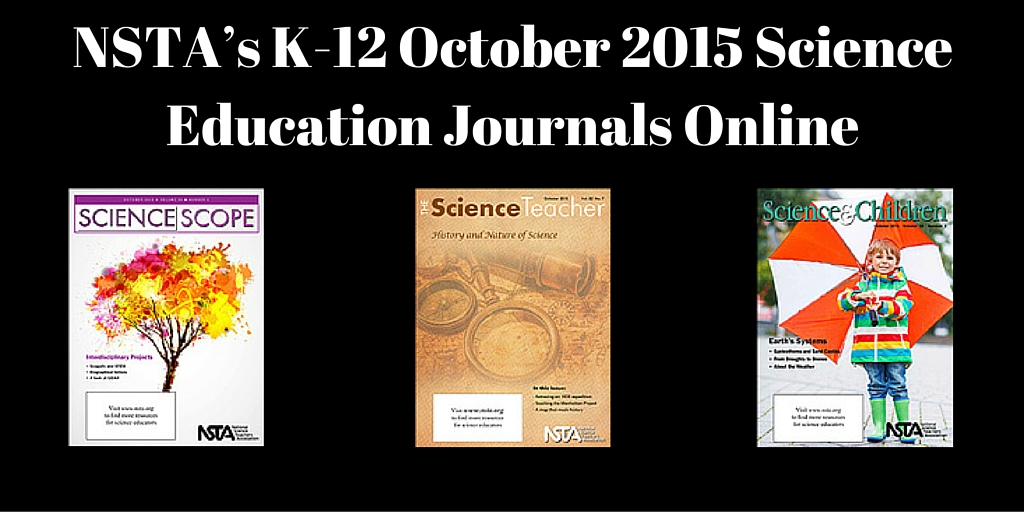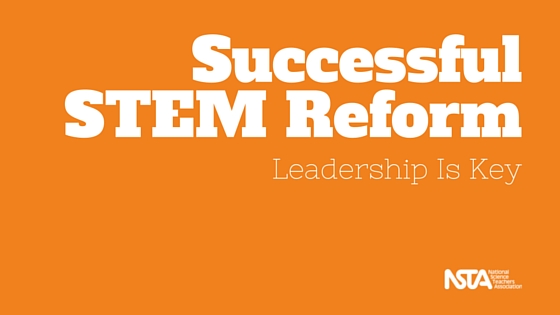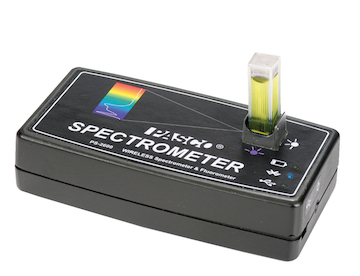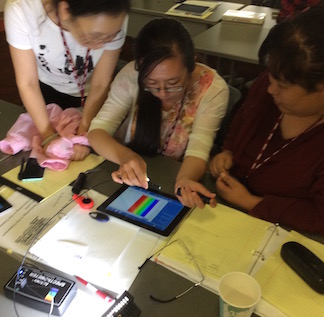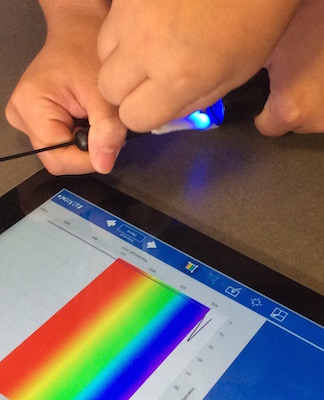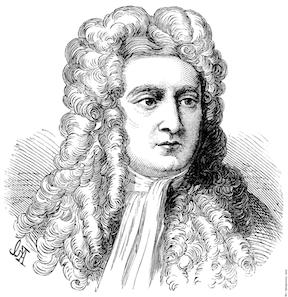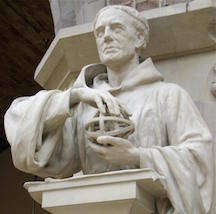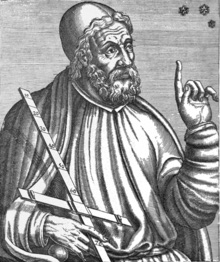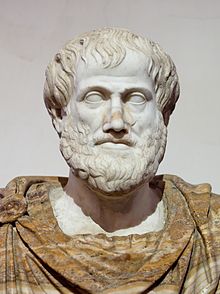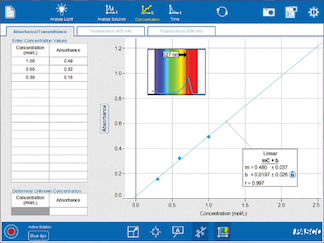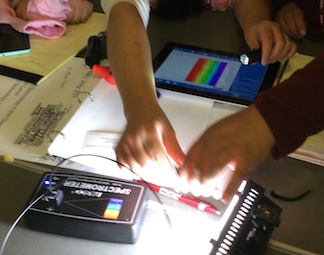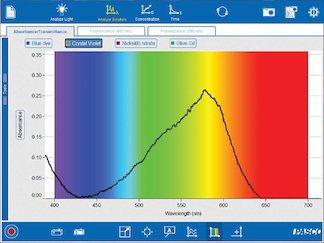#NSTA Social Scene: October 3, 2015
By Lauren Jonas, NSTA Assistant Executive Director
Posted on 2015-10-03
What are science teachers doing in social media this week? Here’s our top 10 favorites!
#1 SHARKTOBER
Is there a better time of year than #Sharktober? We don’t think so! #EarthIsBlue (Photo: @sharkstewards) pic.twitter.com/a2iIsQUF43
— Sanctuaries (NOAA) (@sanctuaries) October 3, 2015
#2 Science Teachers Rock!
Keynote @ainissaramirez reminding science teachers that their power is to rock people’s world #cascience15 #NGSS pic.twitter.com/CjWPzLhLWK
— Jill Grace (@flabellinaJG) October 2, 2015
#3 Must Read
#Teaching Manhattan Project #chemistry #civics in latest issue of Science Teacher @TST_NSTA @NSTA #cdnedchat #edchat pic.twitter.com/CVI1zzIKAK
— Niels Walkau (@walkau) October 3, 2015
#4 Save The Date
Q & A for HS Students and Scientists/Astronauts about #YearInSpace -Thrs Oct 8th 9 pm EDT on #scistuchat – http://t.co/KefasTPIQV
— Adam Taylor (@2footgiraffe) October 4, 2015
#5 Astronaut Alert
Hangin w/ Barbara Morgan as @NSTA plans next gen @Exxonmobil Phil Mickelson Teachers Academy http://t.co/GOC7nM580n pic.twitter.com/1hn5c7jeZu
— Al Byers (@alsbyers) October 1, 2015
#6 Rethink STEM Reform
How do you achieve successful #STEM reform? Cary Sneider weighs in on the #NSTA blog! http://t.co/xMvYgnrhxl pic.twitter.com/3X0P2hr3UX
— NatSciTeachAssoc (@NSTA) October 2, 2015
#7 Mars Onscreen
Science Goes To The Movies: Hear @astro_Pettit and @tweetsoutloud review @MartianMovie http://t.co/O7T3VFF2Pz pic.twitter.com/oIeGhuxwi3
— Science Friday (@scifri) October 3, 2015
#8 Candies Not Optional
Bring: Chewy & cube caramels, jelly candy, American & European gummy bears, candy corns! http://t.co/El4LfjCql3 pic.twitter.com/1I8Uuq67JA
— ACS Webinars (@acswebinars) October 2, 2015
#9 Eye in the Sky
.@Universetoday Borderline Cat 5 Hurricane Joaquin Spied from International Space Station: C… http://t.co/P8ReMDBuNT #astronomy #space
— BlackPhysicists (@BlackPhysicists) October 3, 2015
#10 ICYMI
#NGSSchat #wiki is updated! Check it out here: http://t.co/eJSz2gUHN1. Thanks to @2footgiraffe for the #Storify!
— Fred Ende (@FredEnde) October 3, 2015
Meeting the Demand for Future STEM Teachers
By Debra Shapiro
Posted on 2015-10-02

Third graders in Hofstra University’s STEM Studio ponder how to display the data generated from their pre-exercise/post-exercise pulse rate experiment. Photo courtesy of HOFSTRA UNIVERSITY
The University of Virginia (U.Va.) made headlines in August when it announced its new five-year, undergraduate dual-degree program that will allow students to earn a bachelor’s degree in engineering and a master’s degree in teaching, along with a license and endorsement in chemistry, physics, or math. U.Va. joins other universities around the country in offering these programs to meet the demand for science, technology, engineering, and math (STEM) teachers.
“The impetus [for U.Va’s new program] is the Next Generation Science Standards (NGSS),” says Jennifer Chiu, assistant professor in the university’s Curry School of Education. The new standards “place a lot of emphasis on engineering, but most science teachers have a background in science, not engineering. [The dual degree provides] an opportunity to encourage those with an engineering background to become science teachers and to incorporate engineering into science classrooms,” she explains.
The dual degree also was created “out of student interest,” says Chiu. Advisors have reported that engineering students have expressed interest in teaching, with many “suggesting a possible career pathway [of using] their engineering degree for the benefit of society,” she relates.
Students who complete the program “come out with an engineering bachelor’s degree and can work in industry, and are certified to teach in multiple content areas in Virginia.” They earn endorsements in physics, chemistry, and math because engineering degrees require a lot of basic foundation courses in those subjects; “biology and Earth science endorsements involve courses not as prevalent in the engineering major,” she explains.
U.Va. is offering scholarships to students who apply for the program. Ten $10,000 scholarships were awarded this semester, and “five or six” that will “fully fund the students for the master’s portion” are expected to be awarded next year, according to Chiu. “We’re trying hard to get people through [the program],” she adds.
The university also offers experiences to support students in becoming practicing teachers. “Field placements provide opportunities to teach peers science and engineering in methods courses, and weekly student teacher seminars present strategies and solutions to engage students in ways that reflect the practices of the NGSS,” she notes.
Recruiting Engineering Students
Last winter, Philadelphia’s Drexel University launched DragonsTeach, a new program that gives STEM majors the opportunity to minor in STEM education and obtain secondary teaching certification along with their STEM degree. DragonsTeach is a collaborative effort of the College of Arts and Sciences, the College of Engineering, and the School of Education, and is supported by a $1.45 million grant from the National Math and Science Initiative. Eligible students include chemistry, biology, physics, mathematics, and engineering majors.
DragonsTeach arose, in part, from Drexel’s desire to improve the quality of STEM education in the Philadelphia region, as well as its commitment to become the most civicly engaged university in the country. “As a result of the university-wide emphasis on community and education,” says Jason Silverman, DragonsTeach co-director, “a lot of our STEM students are interested in K–12 work, and through DragonsTeach, these students are able to provide meaningful STEM lessons and experiences to Philadelphia students while learning about a career in education.”
DragonsTeach is a partner of the nationally acclaimed UTeach program established by the University of Texas at Austin. “DragonsTeach is unique because it offers an opportunity to recruit engineering students into teaching,” says Jessica Ward, DragonsTeach director of operations. “Historically, UTeach has had difficulty recruiting engineers,” she reports.
Additionally, because Drexel is a five-year, co-op institution, “[t]his means that while students are completing their undergraduate degrees, they can also complete up to 18 months of work experience,” she explains, “so we are recruiting students who are already career-oriented.”
As an incentive beyond additional career options, DragonsTeach provides a stipend to students who earn a B or better in the two introductory recruitment courses: Inquiry Approaches to Teaching and Inquiry-Based Lesson Design. In these courses, DragonsTeach students teach lessons in elementary and middle schools, and “the younger students’ energy and interest in the STEM activities ultimately excite our DragonsTeach students about teaching,” Ward says.
The first two courses help students “know sooner rather than later if teaching is right for [them],” she notes. And after taking them, “even if you don’t want to teach, a lot of the skills learned are applicable to any career,” she contends.
For example, if a student opts for graduate school, he or she will find “the 5E model is good for a teaching assistant job in any major,” she points out. DragonsTeach courses foster communication and leadership skills; co-teaching prepares students “to work in a team environment”; and designing lessons increases creativity and shows students “how to get someone interested in the material you’re trying to convey,” she asserts.
DragonsTeach students teach high school students in subsequent courses, such as Knowing and Learning in Science and Mathematics, in which “students begin to delve into the NGSS,” Ward relates.
Focusing on Engineering Design
Twenty years ago, Dave Burghardt, engineering professor at Hofstra University in Hempstead, New York, co-created a STEM master’s degree program with “children’s engineering and engineering design at its heart,” he explains. Elementary teachers in the program develop the “knowledge, skills, and attitudes essential for using informed engineering design as a pedagogical strategy in K–12 STEM education,” according to the program’s description. The goal is “design-based activity,” says Burghardt.
With that degree program in mind, Burghardt decided to create “an accessible bachelor’s degree in STEM as a co-major for elementary education majors.” The degree would not require a lot of math courses; it just required “basic algebra, logic, and [an] understanding of math systems, along with introductory, non-major courses in chemistry, biology, and astronomy, and lots of hands-on learning,” he asserts, noting that most bachelor’s degree programs for elementary education majors only require one math and one science course. The degree would feature two STEM capstone courses to provide a broad understanding of the scientific and mathematical foundations of the natural and human-made worlds.
Best of all, every course except the two capstone courses already were being taught at Hofstra. “It was an effective way to use existing resources and can be replicated easily at other schools,” he maintains. “The capstone courses make it unique.”
Burghard
t’s creation, the “BA in STEM, always has engineering design at heart because it enhances a lot of kids’ creativity,” he contends. The degree features “children’s engineering as a part of elementary educators’ portfolio to make science and math more interesting in the classroom. And it does—we have research supporting that,” he declares.
Students earning the degree “have a broad background in all subjects, but also a strong STEM background,” he explains. He tells students, “It’s very accessible, and you’ll be able to enjoy [teaching the material] and impart that to your students. Kids sense when their teacher likes the subject matter…Even [if] you haven’t been a science star in high school, you can be a good STEM teacher.”
The degree makes students more marketable because “superintendents are looking for people with this background,” he reports, noting that the degree “is totally consistent with the NGSS because of its focus on engineering design. It makes it easier to teach to the NGSS.”
This article originally appeared in the October 2015 issue of NSTA Reports, the member newspaper of the National Science Teachers Association. Each month, NSTA members receive NSTA Reports featuring news on science education, the association, and more. Not a member? Learn how NSTA can help you become the best science teacher you can be.
The mission of NSTA is to promote excellence and innovation in science teaching and learning for all.
Follow NSTA
Do You Know What You Do Not Know?
By Christine Royce
Posted on 2015-10-01
The recent report by the Pew Research Center was titled “A Look at What the Public Knows and Does Not Know About Science” and according to their website found “….. that most Americans can answer basic questions about several scientific terms and concepts, such as the layers of the Earth and the elements needed to make nuclear energy. But other science-related terms and applications, such as what property of a sound wave determines loudness and the effect of higher altitudes on cooking time, are not as well understood.
There is no doubt that American’s or at least American students have been compared to international counterparts on a variety of different assessments throughout the ages. However, this particular study is a bit different in that it takes twelve questions – one per science topic and utilizes it to measure the public’s knowledge about science in general.
As noted in this month’s edition of the Leaders Letter, popular news media outlets picked up this story as well and Live Science summarized the findings in a short and to the point story. A counter point to this study appeared in Science News where it states that the study was “heavy on trivia and light on concepts” and is worth reading for a balanced view on this now trending on social media report on American’s understanding of science.
So, a better question is, do you know what you do not know? Or better yet…. do you know what your students do not know or have misconceptions about?
There are a variety of resources that help teachers tackle common (or not so common) misconceptions in science and some of these include:
- Understanding Science and How It Really Works
- Common Elementary Student Misconceptions in Science
- Uncovering Student Ideas Series from NSTA Press
- Picturing to Learn
Some groups even help you develop your own assessment to test student’s misconceptions:
As an educator or those who work with professional development opportunities, it may be worthwhile to actually test your own conceptual knowledge or build that into an actual PD event utilizing the professional development indexer which is part of the NSTA Learning Center. The Professional Development Indexer helps you diagnose your needs in specific science content areas and provide suggestions of NSTA e-PD resources and opportunities you may want to consider as you plan your professional development (PD). The Indexer does not assign a grade or present a score to the questions you answer, but saves a list of recommended resources for later review.
So how do you address what you don’t know or work to address what student misconceptions are?
The recent report by the Pew Research Center was titled “A Look at What the Public Knows and Does Not Know About Science” and according to their website found “….. that most Americans can answer basic questions about several scientific terms and concepts, such as the layers of the Earth and the elements needed to make nuclear energy.
Documenting weather changes
By Peggy Ashbrook
Posted on 2015-10-01
 As the wind stirs up and we get a full day of long-awaited rain, children arrive at school in rain boots and coats, and a few in soaking wet sandals. Hurricane Joaquin will bring more rain and wind this weekend as it moves north in the Atlantic, hopefully off the coast not inland.
As the wind stirs up and we get a full day of long-awaited rain, children arrive at school in rain boots and coats, and a few in soaking wet sandals. Hurricane Joaquin will bring more rain and wind this weekend as it moves north in the Atlantic, hopefully off the coast not inland.
Taking young children outside to observe the short-term conditions of the atmosphere—weather—is a foundation for later learning about the average daily weather for an extended period of time at that location—climate—as defined by the National Ocean Service of the National Oceanic and Atmospheric Administration.
Visit the National Weather Service’s JetStream: Online School for Weather page and scroll down to see the Köppen climates map. The continental USA has ranges in normal temperatures and amounts of precipitation, so no single lesson plan on weather observations 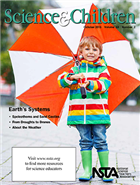 will be a good fit for all. Teaching about your local weather will provide the most opportunities for direct observation that can deepen children’s understanding about weather.
will be a good fit for all. Teaching about your local weather will provide the most opportunities for direct observation that can deepen children’s understanding about weather.
In the October 2015 issue of Science and Children I wrote about children counting and graphing the number of short sleeve shirts, sweaters and jackets that classmates wore to school each day. The clothing is a symbol for the weather, and observing changing trends in outerwear is a focused way to track changes in the immense phenomena that is weather.
NSTA’s K-12 October 2015 Science Education Journals Online
By Korei Martin
Posted on 2015-10-01
Looking for ways to talk about climate change with your students? Are your students curious about the nature of science? Want to know how to create interdisciplinary lessons connected to real-world applications? The October K–12 journals from the National Science Teachers Association (NSTA) have the answers you need. Written by science teachers for science teachers, these peer-reviewed journals are targeted to your teaching level and are packed with lesson plans, expert advice, and ideas for using whatever time/space you have available. Browse the October issues; they are online (see below), in members’ mailboxes, and ready to inspire teachers!
Science and Children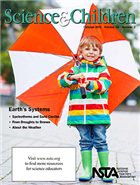
Our rapidly changing climate increases the need for even our youngest students to have a strong background in this area of science. This issue of S&C will help you teach your students about Earth’s systems, with a particular focus on climate.
Featured articles (please note, only those marked “free” are available to nonmembers without a fee):
- Free – Speleothems and Sand Castles
- From Droughts to Drones
- Animal Detectives
- NGSS in Action
- Free – Editor’s Note: Earth’s Systems: Climate
- Free – DCIs, SEPs, and CCs, Oh My!
- Teaching Through Trade Books: Wonderful Water
- Full Table Contents
Science Scope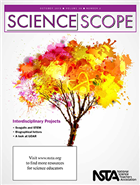
Although middle level science classes often seem self-contained to students, scientific disciplines—and the scientific field at large—do not exist in isolation. The articles in this issue of Science Scope will show you how to collaborate with other science and content-area teachers to create interdisciplinary lessons connected to real-world applications.
- Free – See Less Sea-Less Seagulls: Planning for an Interdisciplinary STEM Unit
- Shrimp and Black Gill: Studying the Effect of Apostome Ciliates
- Free – DCIs, SEPs, and CCs, Oh My! Understanding the Three Dimensions of the NGSS
- Connecting the Dots: Lasers Link Students to Their 3-D World
- Using Biographical Letters to Draw on the Nature of Science
- Using a STEM-Based Approach to Make Recycling Metallic Elements Relevant
- Free – Editor’s Roundtable: Interdisciplinary Teaching
- Full Table of Contents
The Science Teacher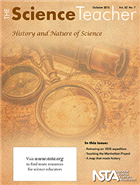
Learning about the nature of science (NOS) is certainly as important as learning about scientific laws and theories. In this increasingly scientific and technological age, personal and societal decisions require a clear understanding of scientific knowledge and how it is generated. NOS tenets need to be intentionally targeted in classroom activities and laboratory investigations and incorporated into all our science teaching. Using case studies from the history of science can help develop students’ understanding of the nature of science and the diverse individuals practicing science and engineering today, as articles featured in this issue illustrate.
Featured articles (please note, only those marked “free” are available to nonmembers without a fee):
- Free – Teaching the Manhattan Project
- William Smith’s Mapping Milestone
- Chemical Solitaire
- A Cool Controversy
- Are We Alone in the Universe?
- Free – DCIs, SEPs, and CCs, Oh My! Understanding the Three Dimensions of the NGSS
- Free – Editor’s Corner: The Nature of Science
- Full Table of Contents
Get these journals in your mailbox as well as your inbox—become an NSTA member!
The mission of NSTA is to promote excellence and innovation in science teaching and learning for all.
Follow NSTA
Build Your Professional Network
By sstuckey
Posted on 2015-10-01
In this video, columnist Ben Smith shares information from the Science 2.0 column, “Build Your Professional Network,” that appeared in a recent issue of The Science Teacher. Read the article here: Build Your Professional Network
[youtube]https://www.youtube.com/watch?v=bxgIKB6WIuM&list=PL2pHc_BEFW2LU1a1jgiLNu4NABGw1Zx-Y&index=66[/youtube]
In this video, columnist Ben Smith shares information from the Science 2.0 column, “Build Your Professional Network,” that appeared in a recent issue of The Science Teacher. Read the article here: Build Your Professional Network
[youtube]https://www.youtube.com/watch?v=bxgIKB6WIuM&list=PL2pHc_BEFW2LU1a1jgiLNu4NABGw1Zx-Y&index=66[/youtube]
Successful STEM Reform: Leadership Is Key
By Guest Blogger
Posted on 2015-09-30
A recent Education Week blog post entitled “STEM Reforms in Needy Schools Eroded Quickly” painted a disappointing picture of STEM education reform. In this post, part 1 of a 2-part series* from the National Science Teachers Association (NSTA), Dr. Cary Sneider (Associate Research Professor at Portland State University in Portland, Oregon) responds.
Schools have a great deal of momentum. They are very difficult to change—especially if just one part of the system is changed without taking into account interactions with other parts of the system. Approving systemic changes to accommodate STEM reform takes political will and therefore support from top educational leaders. Although I don’t know the details of these particular schools, support from top leaders may be a common thread for the problems identified in the report. For example:
Schedule conflicts: The report mentioned scheduling nightmares when guidance counselors tried to fit new STEM courses into existing core requirements. It seems obvious that it would not be possible to incorporate new STEM courses without appropriate modifications to core requirements. The root cause of such a conflict must lie with the people who make policy decisions. If they support STEM reform then they will change the rules to allow it; if they don’t they will block the necessary changes.
State accountability tests: We set an impossible goal when we ask teachers to implement new teaching methods with new goals, and hold them accountable for their students to perform at a high level on the old assessments. New performance-based assessments, consistent with new STEM standards have not yet been developed in any state, and until they are educational leaders should not use inappropriate measures to judge teachers and students.
Personnel changes: The report mentions that courses like physiology and robotics were advertised to students and never actually offered. There could be many reasons why such problems occur (or in this case didn’t occur,) but whatever the reason, teachers were not in a position to offer those courses. Since the deployment of staff to teach various courses is a function of administration, it is likely that these courses did not have sufficient support from the top.
Successful STEM reform addresses these issues from the start. Sneider will be discussing the systemic approach required for educational change on November 7 in the NSTA Virtual Conference Shifting to Integrated STEM: Experiences of Three School Districts. Sneider explains that changing educational systems requires a willingness to examine—and if necessary change—existing policies. He and his co-presenters will give several examples in which systemic changes have brought about significant improvements in STEM teaching and learning. They will also discuss what it takes to implement such changes, including the absolute requirement of support by top leaders. Learn more and register. Register early by Friday, October 9, and save $10 off your registration fee: Use promo code NOV_SAVE10.
 Dr. Cary Sneider is Associate Research Professor at Portland State University in Portland, Oregon, where he teaches courses in research methodology in a Master of Science Teaching degree program.
Dr. Cary Sneider is Associate Research Professor at Portland State University in Portland, Oregon, where he teaches courses in research methodology in a Master of Science Teaching degree program.
Read Part 2 of this series: 3 Key Ingredients for Successful STEM Implementation: Trust, Collaboration, and Innovative Thinking
The mission of NSTA is to promote excellence and innovation in science teaching and learning for all.
Follow NSTA
The PASCO Bluetooth Spectrometer: Even Isaac Newton would flip over the power of this digital prism!
By Martin Horejsi
Posted on 2015-09-30
enty of room left over to inspect rarely explored specimens of light scattered throughout our lives.
- Absorbance and transmittance spectra
- Beer’s Law: concentration and absorbance
- Kinetics
- Fluorescence
- Photosynthesis with DPIP
- Absorption spectra of plant pigments
- Concentration of proteins in solution
- Rate of enzyme-catalyzed reactions
- Growth of cell cultures
- Light intensity across the visible spectrum
- Emission spectra of light sources
- Match known spectra with references




